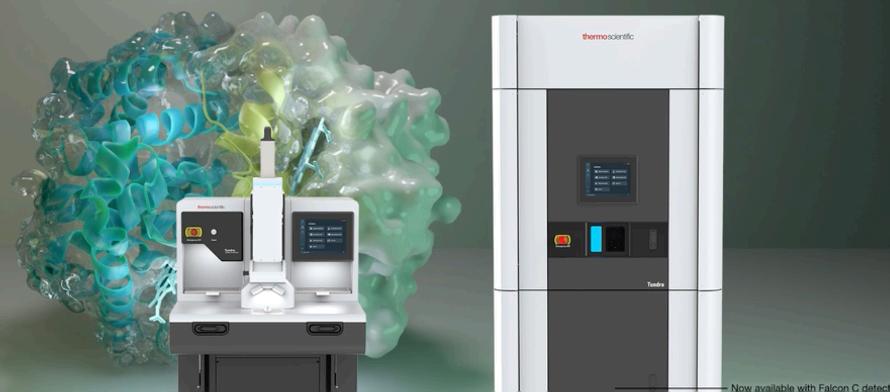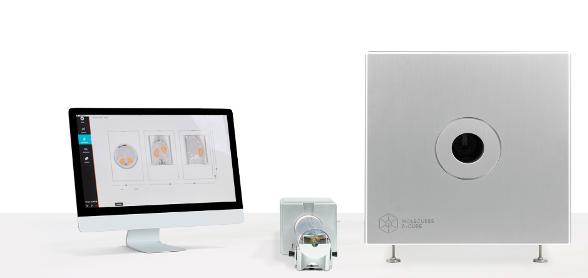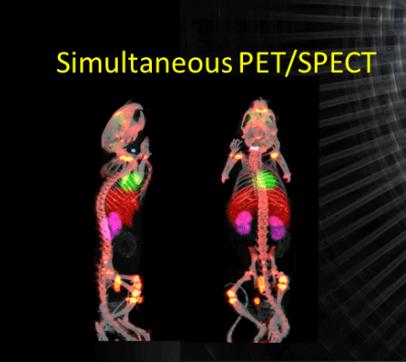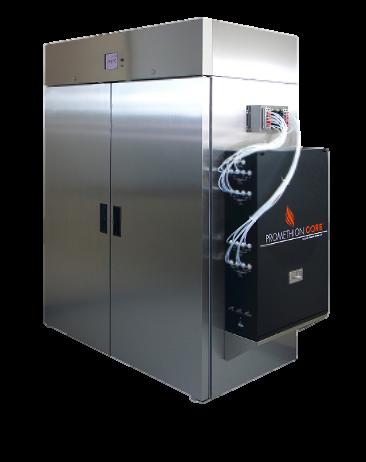




Explore the new cutting-edge scientific technologies in our shared research facilities at Rutgers New Jersey Medical School, where innovations drive groundbreaking scientific discoveries and medical progress.

At Rutgers New Jersey Medical School (NJMS), we are dedicated to advancing medical research and training the next generation of scientists. Our core research facilities serve as an integral part of this mission, providing the tools and resources needed to drive medical breakthroughs that can have a global impact.

The core research facilities at NJMS are at the forefront of scientific discovery, equipped with cutting-edge technology, and home to internationally renowned researchers This resource plays a vital role in advancing medical knowledge and fostering innovation in key research areas such as neuroscience, cancer research, and infectious diseases The facilities are led by world-class researchers and external partners, driving breakthroughs that improve patient care and public health
TheOfficeofResearchprovides:
A collaborative research environment that encourages cross-disciplinary innovation
High-quality equipment and cuttingedge technology to support your research endeavors.
Opportunities to work alongside worldrenowned researchers who are making groundbreaking discoveries.

Learn more about the NJMS Office of Research.
njms.rutgers.edu/research


Scientific Director: Patricia Fitzgerald-Bocarsly, PhD
Technical Director: Sukhwinder Singh, PhD

njms.rutgers.edu/fcic
Housed in the Regional Biocontainment Laboratory (see below)


The BD FACS Symphony A5 SE is a high-performance flow cytometer analyzer for single-cell multiparameter analysis, equipped with a full-spectrum detection of light emissions by fluorescent probes. This technology allows researchers to detect up to 48 different biomarkers parameters.
The Intellifex-RUO xMAP is a high-throughput multiplex platform designed for simultaneous analysis of up to 48 biomarkers using advanced Luminex® technology. This system excels at measuring key immune factors such as cytokines, chemokines, and growth factors, and supports immune assays, including ELISA and ELISpot, and suitable for analyzing serum, plasma, and cell culture samples.

ScientificDirector:VasileiosPetrou,PhD
TechnicalDirector:AlexWei,Ph.D.
The Tundra Next-Generation Cryo-TEM is a cutting-edge tool for microscopic imaging of proteins and macromolecules Featuring a 100kV Transmission Electron Microscope with autogrid capability, it offers high-resolution 2D and 3D imaging at an entry-level. Support instruments include the Thermo Fisher Vitrobot Plunge-Freezer for rapid sample vitrification ensuring highquality cryo-fixation results and a high sample preparation throughput prior to cryo-TEM observation and the Agar Scientific Easiglow Glow Discharge System to support sample grid preparation.

Thermo Fisher Vitrobot Plunge-Freezer

Agar Scientific Easiglow Glow Discharge System


ScientificDirector:DongfangLiu,PhD
TechnicalDirector:LukeFritzky

Scan the QR code to view the lab’s website.
njms.rutgers.edu/cihc
The Akoya Phenocycler Fusion System offers spatial microscopic imaging with precise multiparameter detection of proteins within tissue samples. This system can detect more than 100 different biomarkers simultaneously. Funded by an NIH S10 Grant, PI Jason Weinstein, PhD.



The Zeiss Axioscan 7 is a rapid, high-resolution slide scanner designed for microscopic imaging detection and digitalization of Fluorescence, Brightfield and Polarization signals to automate the collection and data analysis of high resolution images.
The Leica Stellaris 8 tau-STED offers super-resolution confocal ‘nano’ microscopy allowing for the higher resolution of molecular events in tissue biospecimens with extended time for live imaging detection. Funded by an NIH S10 Grant, PI Dongfang Liu, PhD.


Imaris is a state-of-the-art image visualization and analysis software designed for advanced microscopy studies with multidimensional capabilities. It offers powerful tools to enhance our research:
• Imaris Stitcher: Precisely align and fuse multiple microscopy fields into a single image.
• Imaris Track Lineage: Advanced tools for 3D and 4D object tracking with motion and detection capabilities.
• Imaris Coloc: Offers multiple colocalization selection methods, including an automatic mode using an established algorithm.
• Imaris ClearView: GPU-accelerated deconvolution for sharper image quality.
• Measurement Pro: Quantitative analysis for large and complex images
• Filament Tracer: Intelligently traces neurons in 3D with Torch™ technology.
• Imaris Cell: Advanced tools for analyzing individual cells and cell groups.
• Imaris Batch: Processes and analyzes multiple 2D/3D + time images in batch.
• Imaris XT: Allows programmers to add functions and transfer data.
• Imaris Vantage: Visualizes results using interactive multi-dimensional plots.
• Imaris Viewer: Enables easy sharing of your data worldwide.
Illumina 10x Genomics Visium hd (left) and CytAssist and Xenium technologies (right) are used for spatial transcriptomics capable of identifying, quantitating and mapping molecular genomic sequences to microscopic tissue architecture.


Director:MilindMahajan,PhD


njms.rutgers.edu/genomics
The Illumina NovaSeq X Plus is an upgraded high-throughput deep genome sequencing platform designed for faster and more cost-effective sequencing. The new XLEAP-SBS chemistry delivers increased accuracy and instrument performance With a higher throughput volume, it offers singlecell sequencing at half the cost This system is capable of up to 52 billion single reads and 104 billion paired-end reads with onboard cluster generation, and accelerated data analysis using an onboard DRAGEN platform.
The Oxford Nanopore GridION is a long-read nextgeneration sequencing system that supports multiple platforms running together, offering microbiome strain identification and clinical biomarker-filling analysis, filling in sequencing gaps, and providing improved statistical power.
The Agilen BioTek Cytation 7 is a versatile, highthroughput multimodal microplate reader with advanced imaging capabilities It supports automated digital upright and inverted widefield microscopy for fluorescence and brightfield detection with a widerand more sensitive range of fluorophore detection.
**New Spatial Transcriptomics Technology
Joint with Cellular Imaging & Histology Core**
Illumina 10x Genomics Visium hd/CytAssist
Xenium technologies Scan the QR code to view the lab’s website.


RBLDirector:DavidAlland,MD
Animalmodelsandrelatedservices(AMRS)core
CoreDirector:Padmini,Salgame,PhD
Co-Directors:RicardoRajsbaum,PhDandJohnChan,MD
TechnicalDirector:PreetiBharaj

njms.rutgers.edu/rbl

An advanced system for monitoring and measuring in vivo respiratory functions. It goes beyond traditional resistance and compliance mechanics of pulmonary ventilation, and captures crucial details about the mechanical properties of conducting airways, terminal airways and parenchyma
Equipment for Monitoring Respiratory Functions in Infectious Disease Research
Funded by an NIH UC7 Grant, PI Dr. David Alland, MD.

The BD FACSSymphony S6 offers single-cell, multicolor flow cytometry analysis and cell sorting, with the ability to simultaneously collect up to 6 distinct cell subpopulations. This system features full-spectrum detection of light emissions from fluorescent probes, identifying up to 50 biomarker parameters.


A high-throughput benchtop micro-CT scanner designed for preclinical imaging analysis. This scanner will be part of an respiratory infectious disease animal modeling lab in the RBL, supporting studies of bacterial and viral transmission and chronic infection.
Director:EdYurkow,PhD
TechnicalDirector:SushilTripathi,PhD
The MiLab VECTor6 is a multi-modal live imaging system for small animal studies. This system includes PET, microCT, and SPECT imaging capabilities. Applications include regional glucose uptake in tumors / brains; lung injury; bone mineral density and studies monitoring biomaterials and devices. Funded by an NIH S10 Grant, PI Roger Howell, PhD. Scientific Director: Roger Howell, PhD.





Revvity (formerly Perkin Elmer) IVIS Spectrum II
An in vivo animal imaging platform for non-invasive monitoring of disease progression through bioluminescence and fluorescence detection. It offers high sensitivity in deep tissue and can simultaneously image up to 5 mice. The rotating camera enables 3D capabilities, while the software allows co-registration with MiLabs PET, SPECT, and microCT. Scientific Director: Punima Bhanot, PhD.




Director:HongLi,PhD

Scan the QR code to view the lab’s website.
njms.rutgers.edu/capr
Spatial Metabolomics:
Waters DESI-Synapt
This instrument combines mass spectrometry with microscopic detection of metabolites allowing for spatial mapping of molecular events of metabolism within tissue architecture. Scientific Director: Tania Wong, PhD.


**New Mass Spectrophotometer Coming Online** NIH S10 Awarded Bruker timsTOF Ultra 2 LC-MS System for high performance proteomics, PI Hong Li, PhD
A cutting-edge platform for efficient transfection of even non-dividing primary cells, such as resting T cells or neurons, with rapid gene expression and modification. Key applications include the CrisprCas9 technology for site directed mutations, as well as gene expression and deletions.

Promethion Core® (above)
For in vivo metabolic and behavioral phenotyping. This system provides high-resolution, physiological metabolic and behavioral phenotyping in a 22-cage housing setup. It is equipped with a triple gas analyzer (O₂, CO₂, H₂O), 3D infrared beam detection, body weight monitoring, a running wheel module, and an environmental sensor array for recording ambient temperature, light, RH, sound, BP, noise, and motion data.
Scientific Director: Tania Wong, PhD.





This instrument is a high throughput, accurate, precise, and contact-free acoustic transfer system to dispense sample volumes as low as 2.5 nL. Transfers from 96-well to 1536-well microplates are supported, enabling assay miniaturization in a broad range of applications. Funded by an NIH S10 grant, PI David Alland, MD, Public Health Research Institute Center.
